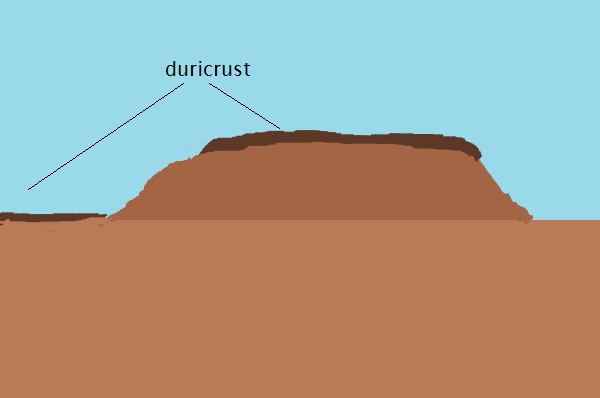 Duricrust img TheGeoRoom
Duricrust img TheGeoRoomDuricrust is a hard crust (layer) found on the surface formed from mineral precipitation. Mineral precipitation is the deposition of insoluble materials from a solution. Minerals such as iron and aluminium are insoluble and when water (solution) evaporates, these minerals are left on or just below the surface where they compact and cement with other materials forming a hard layer.
Duricrusts are very resistant to erosion and weathering and often cap hills or plateaus protecting the underlying soil or rocks from weathering agents.
Different insoluble minerals (metals or compunds) can form duricrusts and usually ends with “crete“ such as:
- Silica which forms silcrete
- Iron, which is more abundant in most duricrust forms ferricrete
- Aluminium which forms alcrete
- Calcium carbonate which when dry forms calcrete
Most duricrusts are mostly found in subtropical regions due to wet and dry periods present there. The wet periods allow soluble materials to be washed away in solution and subsequent dry periods allow more evaporation therefore precipitating (deposited) the insoluble materials.
In arid regions, rapid evaporation causes minerals to precipitate creating resistant hill or plateau tops. Duricrusts containing more than one mineral or metal, for example iron and calcium is termed hardpan.
 A duricrust covering a plateau image source Travelling Australia
A duricrust covering a plateau image source Travelling AustraliaLaterites
Laterites are reddish clay soils rich in insoluble minerals such as iron and aluminium (bauxite). The soluble minerals are leached away leaving insoluble minerals abundant in the soil. Laterites are weathering products. They can form the topsoil or found just below the surface.
Laterites are more or the same as duricrusts in that both are formed from insoluble minerals. In fact, laterites can harden to form duricrust if exposed to air.
The colour of laterites depends on the type of mineral present, for example if iron is more present a reddish colour can be seen.
 Laterite soil img source India Mart
Laterite soil img source India MartLaterites are mostly found in subtropical climates due to wet and dry periods.
Laterites can be used as a building material in most parts of India and can be used for sculptures or monuments
Laterites are very poor for agriculture.
